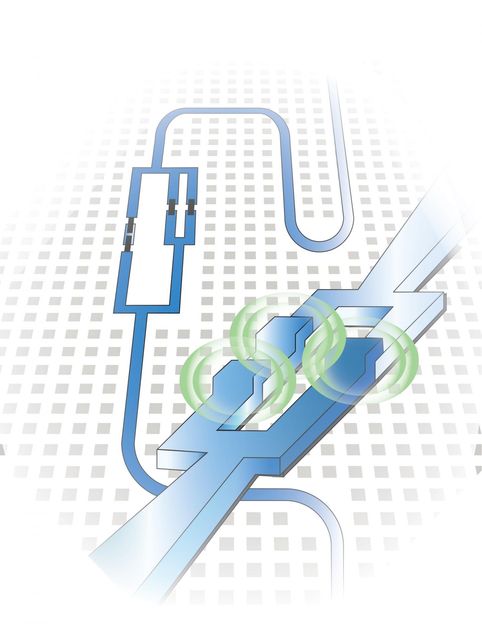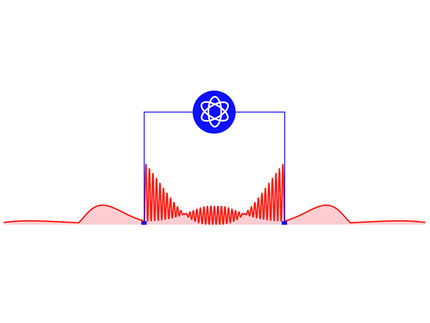Experiment achieves the strongest coupling between light and matter
Researchers at the University of Waterloo's Institute for Quantum Computing (IQC) recorded an interaction between light and matter 10 times larger than previously seen. The strength of the interaction between photons and a qubit was so large that it opens the door to a realm of physics and applications unattainable until now.

This illustration shows a qubit attached to a waveguide where light in the form of microwaves enters and exits.
University of Waterloo
"We are enabling the investigation of light-matter interactions in a new domain in quantum optics," said Pol Forn-Diaz, a postdoctoral fellow at IQC and lead author of the paper. "The possibilities are exciting because our circuit could potentially act as a quantum simulator to study other interesting quantum systems in nature."
The ultrastrong coupling between photons and qubits may lead to the exploration of new physics related to biological processes, exotic materials such as high-temperature superconductors, and even relativistic physics.
To conduct their experiment, the researchers fabricated aluminum circuits in the University of Waterloo's Quantum NanoFab, and then cooled them in dilution refrigerators to a temperature as low as one per cent of a degree above absolute zero. The circuits become superconducting at these cold temperatures, meaning that they can carry a current without resistance or losing energy. These aluminum circuits, known as superconducting qubits, obey the laws of quantum mechanics and can behave as artificial atoms.
To control the quantum state of a superconducting circuit, the researchers sent photons using microwave pulses into the superconducting circuit and applied a small magnetic field through a coil inside the dilution refrigerator. By measuring the photon transmission, the researchers could define the resonance of the qubit, indicated by the reflection of the photons off the qubit. Usually, the qubit resonance is centered around a very narrow range of frequencies.
"We measured a range of frequencies broader than the qubit frequency itself," said Forn-Diaz. "This means there is a very strong interaction between the qubit and the photons. It is so strong that the qubit is seeing most of the photons that propagate in the circuit, which is a distinctive signature of ultrastrong coupling in an open system."
Original publication
Most read news
Original publication
P. Forn-Díaz, J. J. García-Ripoll, B. Peropadre, J.-L. Orgiazzi, M. A. Yurtalan, R. Belyansky, C. M. Wilson & A. Lupascu; "Ultrastrong coupling of a single artificial atom to an electromagnetic continuum in the nonperturbative regime"; Nature Physics; 2016
Topics
Organizations
Other news from the department science

Get the chemical industry in your inbox
By submitting this form you agree that LUMITOS AG will send you the newsletter(s) selected above by email. Your data will not be passed on to third parties. Your data will be stored and processed in accordance with our data protection regulations. LUMITOS may contact you by email for the purpose of advertising or market and opinion surveys. You can revoke your consent at any time without giving reasons to LUMITOS AG, Ernst-Augustin-Str. 2, 12489 Berlin, Germany or by e-mail at revoke@lumitos.com with effect for the future. In addition, each email contains a link to unsubscribe from the corresponding newsletter.


























































